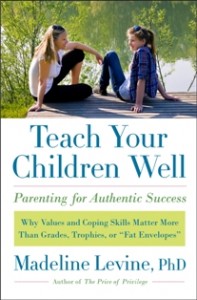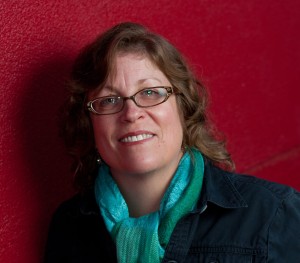Play Pays – By Madeline Levine, PhD
 If you’re like many parents, your child’s summer may already be booked up with “enriching activities.” Maybe you’re shipping him off to a rigorous math or computer camp designed to give him an academic edge. Or perhaps she’ll be living at home but attending an educational day camp or an intensive sports camp. At the very least you’re using the break from school to double up on her (already daunting) schedule of gymnastics and dance classes, supplemented with an ambitious summer reading list.
If you’re like many parents, your child’s summer may already be booked up with “enriching activities.” Maybe you’re shipping him off to a rigorous math or computer camp designed to give him an academic edge. Or perhaps she’ll be living at home but attending an educational day camp or an intensive sports camp. At the very least you’re using the break from school to double up on her (already daunting) schedule of gymnastics and dance classes, supplemented with an ambitious summer reading list.
When will your child have time to play? Just…play?
It’s too bad that the old-fashioned notion of summer as endless free time to climb trees, chase fireflies, build a fort in the woods, maybe set up a lemonade stand, has fallen by the wayside. This is what kids need – they need it far more than they need a high-priced summer camp or some other program aimed at cramming a little bit more learning into their exhausted brains.
Play is serious business. We tend to see it as wasted time, but it’s actually anything but. Play is the work of childhood. It’s a classroom in which children develop a whole set of skills that really matter in life. Indeed, research shows that children who attend play-based preschools, as opposed to academic preschools, do significantly better in school down the line.
David Elkind, one of the country’s most knowledgeable (and beloved) experts on child development, says that “play is essential to positive human development.” He recognizes that there are different types of play: play that teaches children concepts and skills, play that initiates children into the world of peer relations, and play that helps kids develop strategies for dealing with stress.
What these variations on play have in common is that they are self-initiated and self-directed—the playing child is calling the shots.
If a child goes into his room and strums on his guitar because he loves it, that’s play. When an instructor comes into the picture and starts “teaching guitar,” the child may enjoy the experience but he’s no longer playing.
The American Academy of Pediatrics (AAP) recommends that children play outside as much as possible, for at least 60 minutes a day. Unfortunately, almost half of our children aren’t getting any time outside. Sending kids outside to play more often would not only go a long way toward combating our childhood obesity problem (read AAP abstract on this subject here), it would simultaneously allow kids to enjoy more unstructured play. Most experts agree that kids should have twice as much unstructured free time as structured playtime. Every child is different, but as Ken Ginsburg, MD, a leading expert on resilience, says, “What every child needs is free, unscheduled time to master his or her environment.”
If you really want to up the ante, consider that tomorrow’s adults may need the skills developed by play innovation, collaboration, problem solving, and so forth, more than any other generation before. The global economy demands them. This makes it even more ironic that time for free, unstructured, self-directed play is at an all-time low.
So what, exactly, is it that makes play so valuable?
It miniaturizes the world so that kids can deal with it. Play primes children for learning. Toddlers, for instance, love to climb up and down stairs. This allows practice in reading visual cues (i.e., the height of each stair) that plain-old walking doesn’t provide. School-age children play games that have rules, which initiate them into the social institutions they’ll live and work in all their lives.
Consider the complexities involved in a simple game of chase. The running and turning and ducking under and climbing over obstacles develops motor skills, but that’s just the beginning. Kids have to agree on the game and cooperate with each other, which are social skills. They also have to determine who’s going to be the leader, who’s going to be the follower, and when it’s time to renegotiate the roles.
This is just a small example but it shows why we should not be dismissive of play. Kids can learn more from a game of chase than from a week of leadership camp.
It teaches them how to handle stress and conflict. Consider the spats, arguments, and out-and-out fights kids get into when they’re playing with their friends. If they can’t resolve or at least smooth over their disagreements, then the game will grind to a halt, and that’s not good for anyone.
Solitary play, too, provides plenty of problem-solving practice. Watch a young girl playing with her dollhouse and talking to the dolls: If her “child” steals a cookie from the cookie jar she may try out different ways of handling the situation. Does she scold the child? Bash her over the head? Kick her out of the house?
Business leaders say that today’s young workers have a serious dearth of problem-solving skills. While it may seem counterintuitive, making more time for play may give your child a serious edge when she enters the business world.
It’s a feast for the senses – and the senses are the vehicles for childhood learning. You can explain a concept to children all day and they won’t get it. You can show them in a classroom laboratory, and, sure, they may “get it” on some level. But when they discover it themselves by doing, not by listening to someone talk, ah, that’s when the light bulb really comes on.
You might tell a child, “Twelve ounces is twelve ounces no matter what kind of shape it takes.” But when he’s playing with a glass of water and pours it into a short, fat bowl, and then pours the same water into a tall, skinny glass, he sees what you mean. Kids do not have the capacity for abstract thinking. They learn by doing. And that’s what playing is all about: doing.
It gives kids a sense of power in a world in which they are essentially powerless. This is why kids love pretend dragon-slaying so much: They are helpless in the face of real-world “dragons” like parents, teachers, and other authority figures. Try to remember what it felt like to be small and powerless. Much of children’s fiction is based on this theme (think of Dorothy and her terrified friends as they approach the daunting image of the fake Wizard of Oz).
In order to push out into the world, to take risks and to craft ethical positions, kids need to feel that they have some impact on the environment. This gets rehearsed in play, helping to get kids ready to stand up to the school bully or to resist peer pressure.
It bridges the gap between imagination and creativity. All children are imaginative. Anyone who has ever seen a little girl wearing a white bathrobe and a towel draped over her head pretending she’s getting married or a little boy using a stick he found in the yard to cast wizard spells at the family dog has seen that imagination in action. Self-directed play cultivates that imagination into creativity.
And here’s the thing: The ability to innovate – to quickly connect dots that may not be readily apparent – is critical in a workplace where the pace is blistering and customers have limitless choices. A major study conducted by IBM found that the single most sought-after trait in CEOs is creativity. (“IBM Capitalizing on Complexity,” Insights from the Global Chief Executive Summary, 2009)
If you want to develop that skill in your kids, let them play freely and often. Do not impose form and structure. Shun pre-packaged experiences and pre-packaged toys when you can.
It teaches us about ourselves. Our sense of self must be shaped internally, not externally. We need to learn what we’re good at and not good at – what we like and don’t like – on our own rather than being told by parents, coaches, and instructors. This is why it’s so important to let our kids try out lots of different activities (art, music, soccer, karate, gymnastics) rather than immersing them full-time in one or two that you prefer. It’s also why they need plenty of time not devoted to any structured activity at all.
In every episode of unstructured, unguided play, a child learns more and more about him or herself. It is this sense of self that provides a home base, a place to retreat to, throughout life.
Self-directed play is better for kids because ultimately they will have to turn back on their own resources and their sense of self. If they don’t have that they will be always looking for external direction and validation. Business leaders are saying that this constant looking outside for validation makes for workers who need too much time, resources and direction.
Kids who have no down time and no time for unstructured play never get to know themselves. They know only who others tell them they are. Getting to know oneself takes time and emotional energy, and when all that is spent trying to get a leg up on an academic career, or become the best soccer player on the field, there is no time left for the internal work of child development.
Learning who you are takes place not in the act of doing but in the quiet spaces between things. The more of these quiet spaces you can provide your kids, the better.
Nine Ways to Let Your Kid Be a Kid This Summer:
If you’re ready to change your high-pressure, over-scheduling ways, summer is the perfect time to get started. Here’s how:
First, YOU have to buy in to the belief that play is important. Unfortunately, this is tough for many parents. We’re steeped in a culture that elevates work and downplays play. When we see our daughter dancing around the living room we think, She’s so talented! She needs dance lessons! But the minute you do this it stops being play.
Read up on the evidence about play. You’ll find it’s far more valuable than force-feeding children “education” at a young age. Research shows that children who attend play-based preschools, as opposed to academic preschools, do significantly better in school down the line. Baby Einstein actually retards, rather than advances, language acquisition. Once you realize that your assumptions are wrong, you’ll be motivated to change your parenting practices.
Think back to your own best memories from childhood. They won’t be the classes or the lessons but the time you were allowed to just be. It’s important to allow your kids this right as well. Children deserve a childhood.
Get back in touch with your own playfulness. Maybe you haven’t really had fun in a long time. Decide this is the summer you’re going to change that. Get in the pool with your kid. Go camping. Dust off your bicycle and go for a spin. When your child sees you playing, she will be more willing to play, too.
Kids really do model what they see. Plus, part of your job is to present a picture of adulthood that your children will want to emulate. If all they see you doing is working, or sitting around watching them play baseball, why would they ever want to grow up?
Explain to your kids that you’re going to “back it off” a bit this summer. Tell them you’re worried that they’re too busy to really have any fun and that you want to help them change that. Then, ask them to help you create a summer “bucket list.” What would they really like to do this summer?
Don’t be surprised if they don’t know how to answer that question. If they’ve been overbooked and overscheduled all their lives, they’re not used to thinking this way. Part of the joy of this summer will be in seeing their sense of play emerge.
Ask them which activities they want to keep…and which they want to toss. Gently explain to them that swimming, Scouts, gymnastics, and twice-a-week piano lessons is too much “doing” for this laid back summer. Ask them to figure out their least favorite activity (or maybe two) and then cancel it.
You may be shocked by what they tell you they want to quit doing. If your son has been on the swim team for several years and seems to love it, you may be shocked when he asks to quit. Sometimes our kids do things because we want them to, and somehow we failed to notice their heart has never been in it.
Pencil in some low-key friends and family time. This may mean saying no to some invitations. Or it may mean setting aside one evening as family night. Just make sure kids have substantial blocks of time to just hang out with you or with friends. (Surprise…even video games aren’t that bad in limited quantities.)
The point is to make sure there is plenty of free time available for the kids to just be kids. If you don’t set aside the time, and guard it with your life, you’ll just end up keeping your usual chaotic schedule by default.
Encourage free-range (not pre-packaged) play. The more natural and spontaneous the play is the better. A sandbox in the backyard is better than an amusement park. Blocks are better than a plastic bat cave. Impromptu games of neighborhood soccer are more valuable than soccer camp.
Be aware that loafing and hanging out are more valuable than you think. The next time you’re tempted to tell your kid, “Why don’t you go do something!” rethink your belief that busy is always better. Even if it doesn’t look like kids are doing much, a lot of learning may be going on. Never underestimate the value of lying in the grass looking at the sky, or sitting on the sidewalk sharing a stick of gum with a friend.
Finally, trust your kids enough to give them some freedom. Choice is the hallmark of true play. Have confidence that when your child is off on his own and enjoying himself and directing himself in activities he chooses…well, that is his job. Chances are, whatever he’s doing of his own free will is better than any “enriching” activity you might impose on him.
About the Author: Madeline Levine, PhD, is a clinician, consultant, and educator; the author of New York Times bestseller The Price of Privilege and Teach Your Children Well; and a co-founder of Challenge Success, a program founded at the Stanford School of Education that addresses education reform and student well-being. She lives outside San Francisco with her husband and is the proud mother of three newly minted adult sons. For more information, please visit www.madelinelevine.com.
















